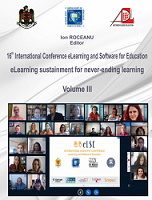RAPID MODELLING TECHNIQUES FOR 3D RECONSTRUCTION OF HISTORICAL BUILDINGS, FOR IMMERSIVE VIRTUAL ENVIRONMENTS
RAPID MODELLING TECHNIQUES FOR 3D RECONSTRUCTION OF HISTORICAL BUILDINGS, FOR IMMERSIVE VIRTUAL ENVIRONMENTS
Author(s): Ana-Karina Nazare, Alin Moldoveanu, Florica Moldoveanu, Alexandru Grădinaru, Maria Anca Băluțoiu, Victor AsaveiSubject(s): Museology & Heritage Studies, Architecture, ICT Information and Communications Technologies, Distance learning / e-learning
Published by: Carol I National Defence University Publishing House
Keywords: 3D reconstruction; modelling techniques; serious games; preservation; virtual reality; cultural heritage;
Summary/Abstract: As we roam further into the future, digitization becomes an essential tool in thinning the barrier between the physical and cyber worlds. We grow expectations of bringing more and more of the world at our fingertips, and eventually being able to access data or experiences by the means of easily operable electronic devices. Reviving the libraries use, especially in academic context, by augmenting their spaces through Augmented Reality techniques or mirroring their spaces in Virtual Reality, eases the training of the readers in knowing and using the library, and provides a solid foundation for plenty of new collaborative experiences for readers and visitors. Additionally, the 3D reconstruction of libraries, needed for Virtual Reality, provides an opportunity to disseminate online such rich cultural spaces, and preserve their patrimonial value. This paper presents the case study of 3D reconstructing the University Central Library of Bucharest. First, we briefly present related work. Then, we analyse various reconstruction techniques. Latest hardware and software advances open a wide range of new reconstruction methods, each having advantages, costs and limitations. We discuss both automatic and manual reconstruction, and combinations of both. Next, we identify and analyse the problems to be solved for our reconstruction subject and pinpoint solutions offering fidelity, rapid reconstruction, moderate use of resources, and sufficient performance for real-time applications (including VR). Finally, we detail, through practical examples, the solutions or optimal techniques, depending on the characteristics of the part to be modelled. Together, they all form an efficient hybrid solution satisfying our objectives.
Journal: Conference proceedings of »eLearning and Software for Education« (eLSE)
- Issue Year: 16/2020
- Issue No: 03
- Page Range: 523-531
- Page Count: 9
- Language: English

